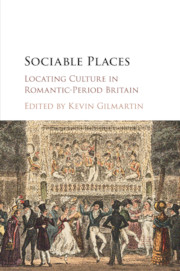35 results
Introduction
-
-
- Book:
- Sociable Places
- Published online:
- 04 July 2017
- Print publication:
- 24 April 2017, pp 1-30
-
- Chapter
- Export citation
Part IV - Traveling Sociability
-
- Book:
- Sociable Places
- Published online:
- 04 July 2017
- Print publication:
- 24 April 2017, pp 183-246
-
- Chapter
- Export citation
Select Bibliography
-
- Book:
- Sociable Places
- Published online:
- 04 July 2017
- Print publication:
- 24 April 2017, pp 247-258
-
- Chapter
- Export citation

Sociable Places
- Locating Culture in Romantic-Period Britain
-
- Published online:
- 04 July 2017
- Print publication:
- 24 April 2017
Part I - Print Relations
-
- Book:
- Sociable Places
- Published online:
- 04 July 2017
- Print publication:
- 24 April 2017, pp 31-94
-
- Chapter
- Export citation
Part III - Interior Places
-
- Book:
- Sociable Places
- Published online:
- 04 July 2017
- Print publication:
- 24 April 2017, pp 141-182
-
- Chapter
- Export citation
Contributors
-
- Book:
- Sociable Places
- Published online:
- 04 July 2017
- Print publication:
- 24 April 2017, pp ix-xi
-
- Chapter
- Export citation
Illustrations
-
- Book:
- Sociable Places
- Published online:
- 04 July 2017
- Print publication:
- 24 April 2017, pp vii-viii
-
- Chapter
- Export citation
Contents
-
- Book:
- Sociable Places
- Published online:
- 04 July 2017
- Print publication:
- 24 April 2017, pp v-vi
-
- Chapter
- Export citation
Acknowledgments
-
- Book:
- Sociable Places
- Published online:
- 04 July 2017
- Print publication:
- 24 April 2017, pp xii-xii
-
- Chapter
- Export citation
Part II - Sociable Spectacle
-
- Book:
- Sociable Places
- Published online:
- 04 July 2017
- Print publication:
- 24 April 2017, pp 95-140
-
- Chapter
- Export citation
Index
-
- Book:
- Sociable Places
- Published online:
- 04 July 2017
- Print publication:
- 24 April 2017, pp 259-270
-
- Chapter
- Export citation
Copyright page
-
- Book:
- Sociable Places
- Published online:
- 04 July 2017
- Print publication:
- 24 April 2017, pp iv-iv
-
- Chapter
- Export citation
Contributors
-
-
- Book:
- Capnography
- Published online:
- 05 August 2011
- Print publication:
- 17 March 2011, pp ix-xii
-
- Chapter
- Export citation
9 - Counter-revolutionary culture
-
-
- Book:
- The Cambridge Companion to British Literature of the French Revolution in the 1790s
- Published online:
- 28 July 2011
- Print publication:
- 10 February 2011, pp 129-144
-
- Chapter
- Export citation
27 - Romanticism and religious modernity: from natural supernaturalism to literary sectarianism
- from Part IV - The Ends of Romanticism
-
-
- Book:
- The Cambridge History of English Romantic Literature
- Published online:
- 28 May 2009
- Print publication:
- 05 March 2009, pp 621-647
-
- Chapter
- Export citation
Index
-
- Book:
- Writing against Revolution
- Published online:
- 22 September 2009
- Print publication:
- 11 January 2007, pp 311-316
-
- Chapter
- Export citation
5 - Southey, Coleridge, and the end of anti-Jacobinism in Britain
-
- Book:
- Writing against Revolution
- Published online:
- 22 September 2009
- Print publication:
- 11 January 2007, pp 207-252
-
- Chapter
- Export citation
Illustrations
-
- Book:
- Writing against Revolution
- Published online:
- 22 September 2009
- Print publication:
- 11 January 2007, pp viii-viii
-
- Chapter
- Export citation
Acknowledgments
-
- Book:
- Writing against Revolution
- Published online:
- 22 September 2009
- Print publication:
- 11 January 2007, pp ix-x
-
- Chapter
- Export citation

